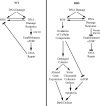An ever-changing landscape in Roberts syndrome biology: Implications for macromolecular damage
- PMID: 33382686
- PMCID: PMC7774850
- DOI: 10.1371/journal.pgen.1009219
An ever-changing landscape in Roberts syndrome biology: Implications for macromolecular damage
Abstract
Roberts syndrome (RBS) is a rare developmental disorder that can include craniofacial abnormalities, limb malformations, missing digits, intellectual disabilities, stillbirth, and early mortality. The genetic basis for RBS is linked to autosomal recessive loss-of-function mutation of the establishment of cohesion (ESCO) 2 acetyltransferase. ESCO2 is an essential gene that targets the DNA-binding cohesin complex. ESCO2 acetylates alternate subunits of cohesin to orchestrate vital cellular processes that include sister chromatid cohesion, chromosome condensation, transcription, and DNA repair. Although significant advances were made over the last 20 years in our understanding of ESCO2 and cohesin biology, the molecular etiology of RBS remains ambiguous. In this review, we highlight current models of RBS and reflect on data that suggests a novel role for macromolecular damage in the molecular etiology of RBS.
Conflict of interest statement
The authors have declared that no competing interests exist.
Figures


Similar articles
-
Genetically induced redox stress occurs in a yeast model for Roberts syndrome.G3 (Bethesda). 2022 Feb 4;12(2):jkab426. doi: 10.1093/g3journal/jkab426. G3 (Bethesda). 2022. PMID: 34897432 Free PMC article.
-
Stimulation of mTORC1 with L-leucine rescues defects associated with Roberts syndrome.PLoS Genet. 2013;9(10):e1003857. doi: 10.1371/journal.pgen.1003857. Epub 2013 Oct 3. PLoS Genet. 2013. PMID: 24098154 Free PMC article.
-
Improved transcription and translation with L-leucine stimulation of mTORC1 in Roberts syndrome.BMC Genomics. 2016 Jan 5;17:25. doi: 10.1186/s12864-015-2354-y. BMC Genomics. 2016. PMID: 26729373 Free PMC article.
-
The non-redundant function of cohesin acetyltransferase Esco2: some answers and new questions.Nucleus. 2012 Jul 1;3(4):330-4. doi: 10.4161/nucl.20440. Epub 2012 May 22. Nucleus. 2012. PMID: 22614755 Review.
-
Etiology and pathogenesis of the cohesinopathies.Wiley Interdiscip Rev Dev Biol. 2015 Sep-Oct;4(5):489-504. doi: 10.1002/wdev.190. Epub 2015 Apr 7. Wiley Interdiscip Rev Dev Biol. 2015. PMID: 25847322 Free PMC article. Review.
Cited by
-
Thalidomide-induced limb malformations: an update and reevaluation.Arch Toxicol. 2025 May;99(5):1643-1747. doi: 10.1007/s00204-024-03930-z. Epub 2025 Apr 8. Arch Toxicol. 2025. PMID: 40198353 Review.
-
Expert consensus on classification and diagnosis of congenital orofacial cleft.Hua Xi Kou Qiang Yi Xue Za Zhi. 2025 Feb 1;43(1):1-14. doi: 10.7518/hxkq.2025.2024306. Hua Xi Kou Qiang Yi Xue Za Zhi. 2025. PMID: 39840621 Free PMC article. Chinese, English.
-
G1-Cyclin2 (Cln2) promotes chromosome hypercondensation in eco1/ctf7 rad61 null cells during hyperthermic stress in Saccharomyces cerevisiae.G3 (Bethesda). 2022 Jul 29;12(8):jkac157. doi: 10.1093/g3journal/jkac157. G3 (Bethesda). 2022. PMID: 35736360 Free PMC article.
-
Cohesin: an emerging master regulator at the heart of cardiac development.Mol Biol Cell. 2023 May 1;34(5):rs2. doi: 10.1091/mbc.E22-12-0557. Epub 2023 Mar 22. Mol Biol Cell. 2023. PMID: 36947206 Free PMC article.
-
Genetically induced redox stress occurs in a yeast model for Roberts syndrome.G3 (Bethesda). 2022 Feb 4;12(2):jkab426. doi: 10.1093/g3journal/jkab426. G3 (Bethesda). 2022. PMID: 34897432 Free PMC article.
References
-
- Roberts JB. A child with double cleft of lip and palate, protrusion of the intermaxillary portion of the upper jab and imperfect development of the bones of the four extremities. Ann Surg. 1919;70:252–3.
-
- Freeman M, Williams DW, Schimke N, Temtamy SA. The Roberts syndrome. Clin Gen. 1974;5:1–16. - PubMed
Publication types
MeSH terms
Substances
Supplementary concepts
Grants and funding
LinkOut - more resources
Full Text Sources
Medical

